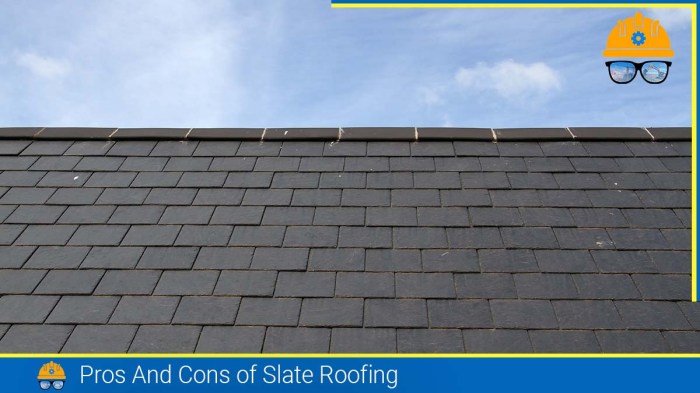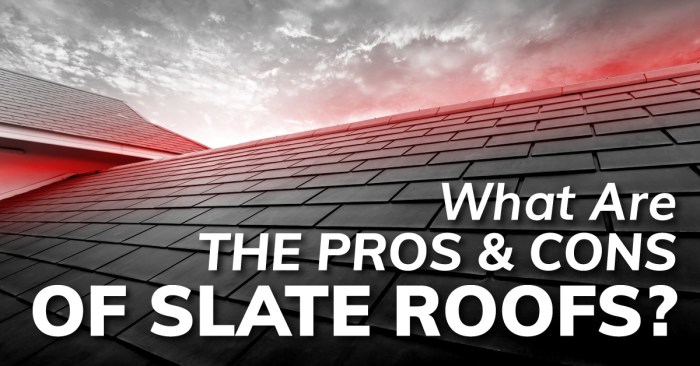Dive into the world of slate roofing as we uncover the advantages and disadvantages of this timeless roofing material. From its durability to maintenance challenges, this topic delves into all aspects of slate roofing in a captivating and informative manner.
In the following paragraphs, we will explore the various facets of slate roofing, shedding light on its longevity, installation process, and more.
Pros of Slate Roofing
Slate roofing offers several advantages that make it a popular choice for homeowners looking for a durable, aesthetically pleasing, and eco-friendly roofing option.
Durability of Slate Roofing
Slate roofs are known for their exceptional durability, with a lifespan of up to 100 years or more when properly maintained. This longevity makes slate roofing a cost-effective option in the long run, as it reduces the need for frequent replacements compared to other roofing materials.
Aesthetic Appeal of Slate Roofs
One of the major advantages of slate roofing is its timeless and elegant appearance. The natural beauty of slate tiles enhances the curb appeal of any home, adding a touch of sophistication and luxury. Slate comes in a variety of colors and textures, allowing homeowners to choose a style that complements their architectural design.
Eco-Friendly Aspects of Using Slate
Slate is a natural material that is sustainable and environmentally friendly. It is a renewable resource that is harvested from quarries, making it a more eco-conscious choice compared to synthetic roofing materials. Additionally, the longevity of slate roofs reduces the amount of waste generated from roof replacements, further contributing to a greener environment.
Cons of Slate Roofing

Installing a slate roof comes with its own set of drawbacks that homeowners should consider before making a decision.
High Initial Cost
One of the main disadvantages of slate roofing is its high initial cost. The price of the slate tiles themselves, along with the specialized labor required for installation, can make it a significant investment compared to other roofing materials.
Weight of Slate Roofing
Slate roofs are heavy compared to other roofing materials. The weight of the slate tiles can put additional stress on the structure of the building. It is crucial to ensure that the roof structure is strong enough to support the weight of the slate tiles to avoid any structural issues in the future.
Maintenance Challenges
Maintaining a slate roof can be challenging and costly. While slate is a durable material, individual tiles can break or become dislodged over time. Repairing or replacing these tiles requires specialized knowledge and skills, which can make maintenance tasks more expensive compared to other types of roofing materials.
Longevity of Slate Roofs

Slate roofing is renowned for its exceptional longevity, outlasting many other roofing materials by decades. When properly installed and maintained, a slate roof can easily last over 100 years, making it a highly durable and cost-effective choice for homeowners.
Comparison with Other Materials
- Slate roofs typically last 2-3 times longer than asphalt shingles, which have an average lifespan of 20-30 years.
- Compared to metal roofs, which last around 50 years, slate roofs have a significantly longer lifespan.
- Even high-quality cedar shake roofs, known for their durability, usually need replacement after 30-40 years, much shorter than slate.
Historical Examples of Longevity
Many historical buildings around the world boast slate roofs that have endured for centuries. Examples include:
- The Buckingham Palace in London, which has had its slate roof since the early 19th century.
- The Smithsonian Institution Building in Washington D.C., with its original slate roof dating back to 1855.
- The Cologne Cathedral in Germany, featuring a slate roof that has been in place for over 800 years.
Installation and Maintenance for Longevity
Proper installation and regular maintenance are key to maximizing the lifespan of a slate roof. Some essential tips include:
- Ensuring the roof is installed by experienced professionals familiar with slate roofing techniques.
- Regularly inspecting the roof for any damaged or missing slates and promptly repairing them to prevent water infiltration.
- Keeping the roof clean from debris and ensuring proper drainage to prevent water pooling, which can accelerate deterioration.
Installation Process
When it comes to installing a slate roof, it is essential to follow a specific set of steps to ensure a successful and long-lasting result. The installation process for slate roofing requires expertise and precision to guarantee the roof's durability and functionality.
Steps Involved in Installing a Slate Roof
- Preparing the roof deck: The first step involves preparing the roof deck by ensuring it is clean, dry, and free of any debris.
- Installing underlayment: A waterproof underlayment is then installed to provide an additional layer of protection against moisture.
- Laying the slate tiles: Slate tiles are carefully laid out in an overlapping pattern, starting from the bottom of the roof and working upwards.
- Securing the tiles: Each slate tile is secured to the roof deck using nails or hooks to prevent them from shifting or becoming loose.
- Finishing touches: Once all the slate tiles are installed, finishing touches such as ridge caps and flashings are added to complete the roof.
Expertise Required for Proper Slate Roof Installation
Proper installation of a slate roof requires a high level of expertise and knowledge in working with this particular material. Roofing professionals who specialize in slate roofing are trained to handle the unique challenges that come with installing slate tiles, such as their weight and fragility.
They understand the importance of proper installation techniques to ensure the longevity and performance of the roof.
Importance of Hiring a Professional for Slate Roof Installation
Installing a slate roof is a complex and labor-intensive process that should not be taken lightly. Hiring a professional with experience in slate roofing is crucial to avoid costly mistakes and ensure the job is done correctly. A professional roofer will have the necessary skills, tools, and expertise to install a slate roof properly, providing you with a durable and long-lasting roofing solution.
Ultimate Conclusion
In conclusion, slate roofing offers a unique blend of elegance and resilience, making it a popular choice for many homeowners. Despite the initial cost and maintenance requirements, the longevity and eco-friendly features of slate roofs make them a worthy investment for those seeking a durable and aesthetically pleasing roofing option.
Clarifying Questions
What is the average lifespan of a slate roof?
Slate roofs can last anywhere from 75 to 200 years, outperforming many other roofing materials in terms of longevity.
Is slate roofing environmentally friendly?
Yes, slate is a natural material that is sustainable and recyclable, making it an eco-friendly choice for roofing.
How does the weight of slate roofing affect a building's structure?
The weight of slate roofing can put strain on the structure of a building, requiring additional support to bear the load.















